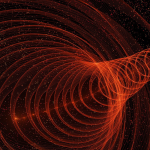New Magnetic Study with Quantum Implications
Background of Ferromagnetic Material & Magnetic Spin
First, let’s talk about ferromagnetic materials! When you break them down, ferromagnetic materials are made of atoms, which are made of electrons. These electrons act like tiny magnets in and of themselves. Typically, the orientations of these “magnets” are aligned within each region; however, each region is not aligned. When a magnetic field is introduced, the magnetic spins (orientations) in the separate regions line up. This is how the material becomes fully magnetized.
This process of the regions lining up does not all happen simultaneously though! The different regions or domains influence each other, so the spin change spreads across the material like an avalanche. The physicist Heinrich Barkhausen was the first to demonstrate this effect in 1919. He wrapped a coil around a magnetic material and attached it to a loudspeaker, showing evidence of these spins through a crackling sound — the Barkhausen noise.
Modern Barkhausen Noise Experiment with Quantum Implications
Recently in a study called “Quantum Barkhausen noise induced by domain wall cotunneling” (funded by the U.S. Department of Energy and the National Sciences and Engineering Research Council of Canada), researchers showed that Barkhausen noise can also be produced in quantum material, showing how quantum effects can lead to macroscopic changes. This process is called quantum tunneling and it may one day impact our ability to create quantum sensors.
In quantum tunneling, particles “can jump to the other side of an energy barrier without having to actually pass over the barrier.” Of course, this is in the quantum world; however, if you were able to scale up this effect, it would be like a golf ball passing straight through a hill vs. going up and over it. That’s because the ball (or the particle) is actually a wave. Christopher Simon, lead author of the paper on quantum tunneling says that in this analogy, “some of [the ball] is already on the other side of the hill.”
An additional finding showed something called co-tunneling. This is where groups of tunneling electrons are communicating to drive spin alignment. Returning to the avalanche comparison, this is like two avalanches happening in sync with each other.
Apex Magnets
This is the latest glimpse into a world of magnetic discoveries! At Apex Magnets, we present a diverse range of magnets to use in business applications, the office, the classroom, or at home. Our products feature ceramic options, powerful neodymium magnets, and more. Find your perfect magnetic match in our catalog of top-notch products!

